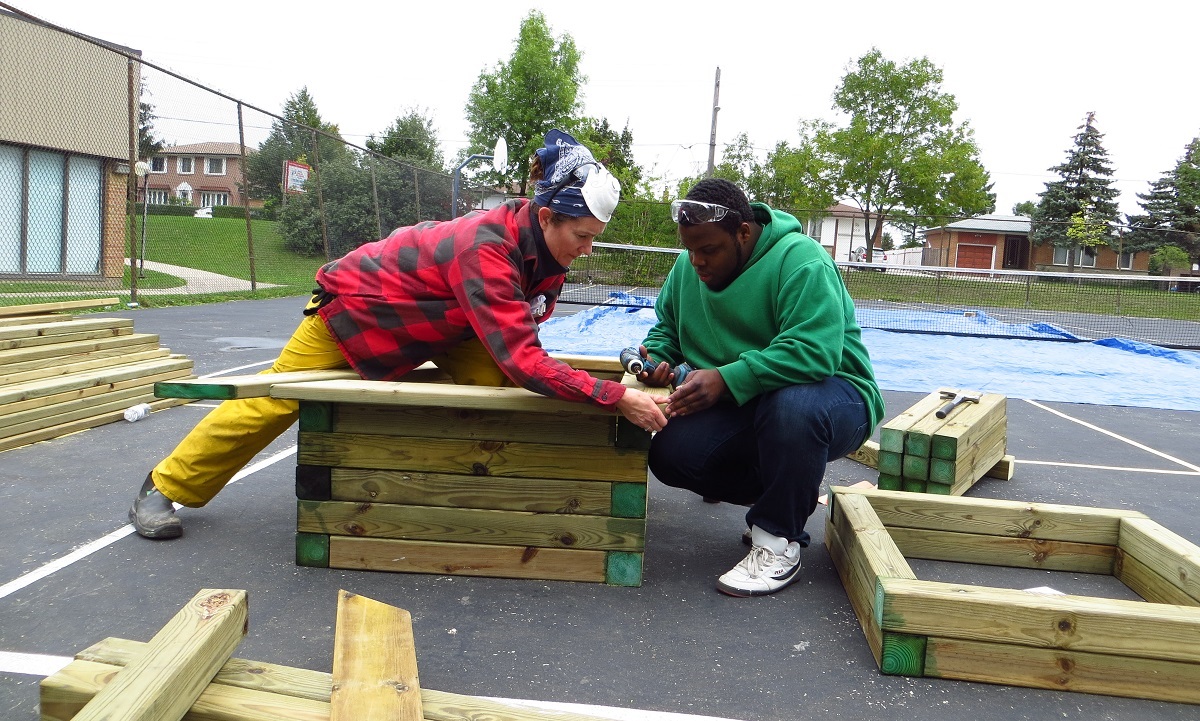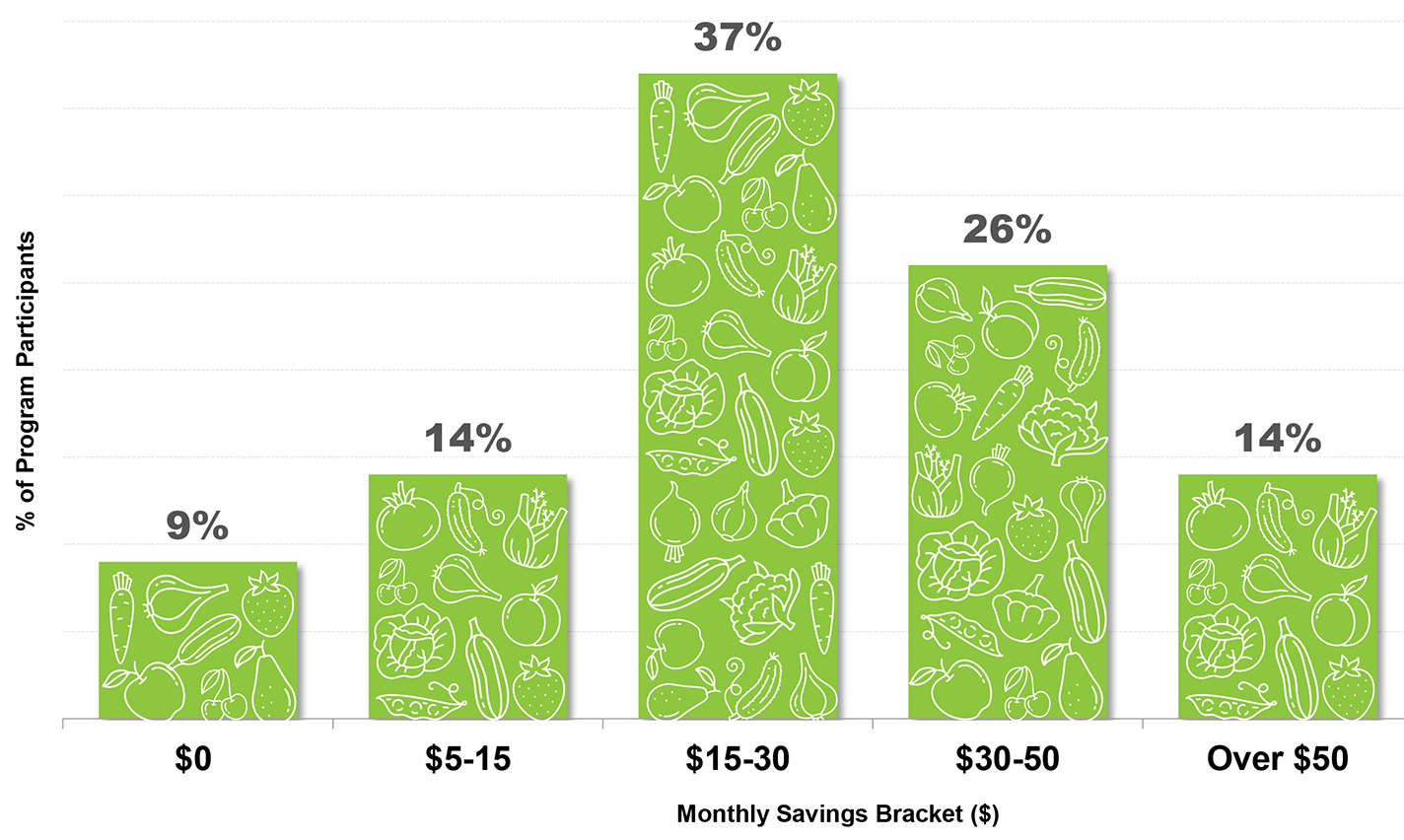Beginning in 2012, Toronto and Region Conservation Authority (TRCA) applied its SNAP model to the revitalization of San Romanoway Towers, a high-rise housing complex in Toronto’s Jane and Finch neighbourhood.
The SNAP program brought together property owners and tenants, as well as City of Toronto, not-for-profits and businesses, to achieve significant environmental, resiliency and socio-economic improvements.
You can explore the highlights of the San Romanoway success story on this page, or download a copy of the final report for a detailed case study.
EXPLORE THE PROJECT
Project Background
Taking action, at the neighourhood level, to address climate and sustainability issues, is an urgent need. It’s also a prime opportunity to address housing concerns and other socio-economic objectives.
The City of Toronto is home to the second-largest concentration of post-war residential towers in North America. These aging buildings house roughly 20% of the city’s population, including some of its most socially vulnerable demographics. Most are inefficient and in urgent need of repair.

The City of Toronto is one of many municipalities that have recognized the need to revitalize privately owned residential towers. The task, however, is a complex one that requires a holistic, multi-disciplinary approach.
Enter TRCA. Our SNAP program takes a neighbourhood-based approach to sustainable urban renewal and climate action. SNAP’s collaborative model addresses property owners’ priorities and tenants’ needs, while considering the surrounding neighbourhood, to achieve environmental and socio-economic benefits.
The San Romanoway Towers Revival project is one of several interconnected initiatives identified in the Black Creek Sustainable Neighbourhood Action Plan in 2012. The project, led by TRCA as a backbone organization, forged innovative implementation partnerships to deliver results.
Project Objectives
The objectives for the San Romanoway Revival project reflected the priorities of the property owners and tenants, as well as those of TRCA and the City of Toronto:
- Increase the tree canopy and improve urban habitat
- Reduce stormwater runoff
- Reduce energy and water consumption and improve buildings resiliency
- Improve tenant satisfaction
- Address food security issues
- Beautify the outdoor areas and develop spaces that encourage community-building, collaboration, and a sense of belonging
- Provide capacity building, as well as green job skills training and income opportunities
- Build stronger community connections to the wider neighbourhood

Getting the Community Involved
The San Romanoway Revival project applied the “Participant to Leader” model created by the SNAP program to actively engage community members and foster community leadership among project participants.
A variety of engagement techniques were used to understand residents’ needs, identify emerging community leaders, and develop trust and excitement:
Pop-up Park
A Pop-up Park event was hosted outdoors on-site in summer 2013, to bring the community together to experience the possibilities of their home landscape. More than 400 residents attended and were encouraged to share their dreams for the transformation of the property.


Focus Groups
Once it became clear that urban agriculture would be a key theme, TRCA engaged FoodShare, a local NGO with expertise in food security, to guide this component of the project. TRCA and FoodShare conducted focus group workshops with residents to explore what plantable areas at San Romanoway could be like.
Resident Tours to other Other Projects
Resident delegates from San Romanoway toured the sites of similar projects elsewhere in the GTA. These tours provided a source of inspiration and an opportunity to consider what components could be successfully incorporated into the San Romanoway project.
Quick-Start Projects
The SNAP model includes the development of quick-start projects early in the planning process to build trust and demonstrate project action. This creates momentum and estabishes the collaborative approach that is so key to the success of SNAP projects.
The San Romanoway Towers Revival featured two quick-start projects:
1. SUSTAINABLE CARPENTRY
A series of introductory carpentry workshops in fall 2013 provided skills training for local at-risk youth, and resulted in the production of outdoor furniture such as benches, picnic tables and planters for the property. The initiative was delivered through a partnership with JVS Employment Services and ContractHer.

2. EDIBLE BALCONIES
Responding to residents’ desire to plant and grow food, TRCA partnered with FoodShare in spring 2014 on a balcony container gardening project. Residents received 60 containers in total, and grew more than 500 pounds of fresh produce. The program was expanded in 2015 to include more than 80 additional balconies.

“I liked very much that we were encouraged to have a say and select whatever ideas or dreams that we thought would make a difference to us in the fulfillment of the San Romanoway Revival project. This got us residents on board right from the project launch.” – Comment from resident
Developing the Plan
To develop the San Romanoway Revival master plan, TRCA launched a crowdsourced international design competition in 2014. The key themes and findings from community engagement became criteria for the online submissions of design concepts.
The top submissions were printed as posters and displayed in the lobby of each tower, where residents were able to “vote” by placing a sticker on their favorite design. In all, 800 people voted.

Once the winning concept was selected, TRCA’s landscape architect grounded the content in a technically sound master plan and design, finalized in 2015. TRCA then led partnerships and contracts with experts to bring many of the master-planned elements to fruition on-site.
Action Areas
Outdoor Revitalization
Transforming Underutilized Spaces into Vibrant Community Development Hubs with Ecological Function
HIGHLIGHTS INCLUDE:
- Community Vegetable Garden
A community vegetable garden with 72 plantable spaces, supported with rainwater harvesting, was installed. An average of 66 households have participated each year. In 2018, residents established their very garden club, headed by an elected committee that organizes, plans, and provides leadership.

- Fruit Tree Orchard
Toronto-based Orchard People partnered to bring expertise and oversight to the installation of a 24-tree on-site orchard. Residents were offered a fruit tree care certification program, to learn how to tend the trees once they were grown. Some became inspired to develop a social enterprise, offering their newly acquired skills to homeowners within the wider community. Some even used the training as a stepping stone to pursue further education and full-time employment in green jobs.
READ A TESTIMONIAL.

- Native Trees, Shrubs, and Pollinator Gardens
Hundreds of native trees, shrubs, and pollinator gardens have been planted by residents and corporate volunteers. These landscaped areas beautify the site, help to increase tree canopy cover, and provide habitat for native species. TRCA and City of Toronto staff have offered natural landscaping sessions for residents, who continue to maintain these areas with the skills they have acquired.

“I got involved in the garden to be involved in a greater sense of community, see people work together, and expand circle of friends.” – Comment from resident survey
Building Retrofits
Achieving Efficiency in Energy, Water, and Waste Management
HIGHLIGHTS INCLUDE:
- STEP Assessment and Physical Retrofits
RPMS, owner of the building at 10 San Romanoway, received an assessment from City of Toronto’s Sustainable Towers Engaging People (STEP) program, which helps property owners access programs and receive support to work on indoor retrofits. The resulting initiatives included: - Project Enlighten: Nearly 7,500 LED bulbs were installed to replace less energy energy-efficient bulbs.
- Combine Heat and Power (CHP): RPMS successfully implemented its first CHP project, a 260kW system that is expected to reduce annual utility costs by 25% while generating approximately 60% of the electricity used by the building.
- Garbage Compactor Technology Upgrade: A new garbage compactor with a fullness indicator display was installed to optimize the scheduling of bin pickups.
- Water Fixture Replacement Program: New water fixtures, including ultra-high efficiency toilets, shower heads, and aerators were installed in all suites.
- Green Champion: Tenant Behaviour Change Project
TRCA worked with City of Toronto to implement the Tower Renewal Green Champions program. The 11 local residents who received training as Green Champions engaged fellow tenants and collected pledges for energy, water conservation, and waste management actions. Results at 25 San Romanoway included: - Electricity consumption was reduced by 2.9%
- Water use was reduced by 5.6%
- Total waste output was reduced by 14.1%
- Recycling increased by 3.1%
“The information gathered through the Green Champion Program has helped us better understand the average consumption habits of our residents. Good information is good for business; the more knowledge we have the better.” – Kris Boyce, CEO Greenwin Corp.
Socio-Economic Impact
The San Romanoway Towers Revival project was designed to deliver social as well as ecological benefits. In an effort to quantify the project’s socio-economic impact, TRCA worked with project partners and United Way to develop and conduct surveys of program participants as well as the wider tenant community.
SURVEY RESULTS: HIGHLIGHTS
Skills Training and Income Opportunities
OPPORTUNITIES TO GROW
More than 70% of Program Participants say they have acquired four or more new skills by participating in SNAP team-led activities.
“It surprises me how much I’ve learned.” – Paul McLean, San Romanoway Resident Leader
|
Have considered adding these skills to their resume |
Feel their job prospects have improved |
Economic Benefits
SAVINGS ON FRUIT AND VEGETABLES
91% of program participants reported saving money on groceries by participating in the garden. A majority of gardeners reported savings between $15 and $50 per month.
“I always felt bad when I look back and see that our community is suffering in terms of not being able to afford to buy healthy food … How do you save money? It is by getting your fruits from your own backyard with no cost.” – Charity Fejokwu, Resident Leader

Community Engagement and Capacity Building
MORE ENGAGED RESIDENTS
From 2013 to 2019, a total of 2,236 hours of programming was delivered. The community returned 42,796 hours of participation from 2,708 participants. Every hour of SNAP program contribution generates 19 hours of community action.
“People communicate. Garden brings people together as family.” – Comment from resident survey
|
Said they were inspired to fundraise for a community cause |
Said the program led them to address community matters |
Community Connections
A MORE INCLUSIVE COMMUNITY
100% of Program Participants reported that being part of the San Romanoway Garden group has made them feel more connected.
“You get to know people and they help you take care of your plot and share produce. Makes people more giving.” – Comment from resident survey
Among all residents surveyed:
|
Agreed that people are developing new friendships through the project |
Agreed that people are now more willing to help their neighbours |
Health and Well-being
ACTIVE LIVING AND BETTER HEALTH
Over seven years, residents have contributed 9,990 hours of participation in active living activities such as vegetable gardening and tree stewardship. 93.5% of total program hours were spent in active living initiatives outdoors.
“The garden creates a sort of love.” – Comment from resident survey
Among program participants:
|
Said the program has increased their intake of fresh fruits and vegetables |
Said the program has had a positive impact on their mood. |
Lessons Learned
There is great opportunity to achieve lasting, positive environmental and social change through the revitalization of aging, privately owned multi-unit residential buildings.
Key lessons learned from the San Romanoway Towers Revival project include:
- Sustainable revitalization and climate action projects in privately owned towers present opportunities to deliver multiple benefits — not only for tenants and tower owners, but also for municipalities, private businesses, and the general public.
- A trusted backbone organization is instrumental in partnership brokering and leading co-designed planning and implementation.
- Privately owned towers can attract funding and resources for revitalization from non-traditional sources by establishing objectives that span environmental, resiliency, and socio-economic themes, and that will benefit society as a whole.
- Investing sufficient time and resources to understand tenants’ priorities and needs, develop trust, and build community capacity is crucial to the success and long-term sustainability of the project.
- Using a neighbourhood-based approach (as opposed to working on a tower-by-tower basis) helps to achieve efficiencies, open up opportunities for tenants, improve community life, and maximize sustainability and resiliency benefits both for the individual tower and for the broader neighbourhood.
- Tracking progress and acknowledging those who contribute to the success of the project will advance fundraising efforts and help to maintain the momentum for long-term sustainability.


















